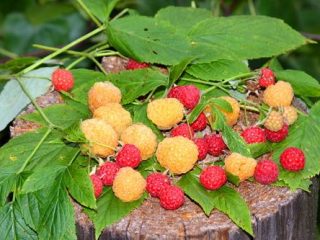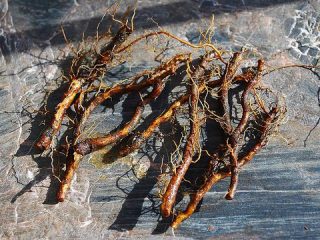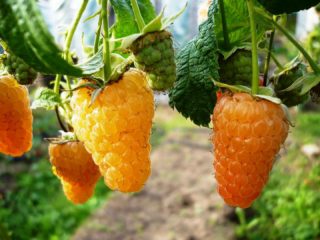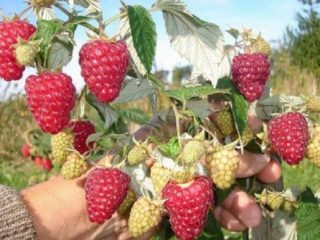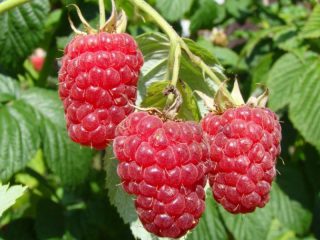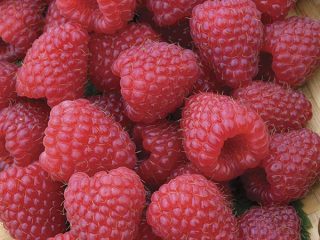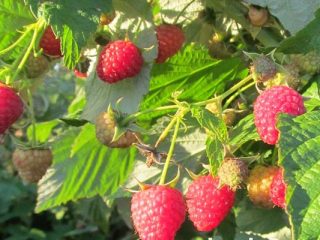Content
Raspberry leaves turn yellow - this problem can appear not only in mid-summer or closer to autumn, but also in spring. It is provoked by bush diseases and pests, as well as improper plant care.
Why do raspberries have yellow leaves?
Raspberries on the site turn yellow in spring and early summer for several reasons. To determine what caused the problem, you need to carefully examine the bush and evaluate the quality of agricultural technology.
Nutrient deficiencies
Raspberries are not particularly capricious. But on poor soils and in the absence of fertilizing, the shrub begins to bear fruit worse, and sometimes turns yellow and sheds its leaves. You can understand which element a plant lacks by its appearance:
- If the development of the bush has slowed down, and the crown has become lighter and faded, this indicates a nitrogen deficiency.
- If the raspberries turn yellow, but bright veins remain on the leaves, we are talking about a lack of iron.
- If the plates first changed color, began to curl at the edges, and then dried out and began to fall off, then there is not enough magnesium in the soil.
- If gray-yellow spots appear on the leaves, and then the greenery begins to crumble, there is a zinc deficiency.
- If the raspberry plates are covered with light yellow stripes and stains, darken along the edges and begin to die, the bushes lack calcium.
You can talk about nutrient deficiency if the plant turns yellow, but there are no traces of pests or fungal diseases on the leaves. To cope with the lack of microelements, it is necessary to apply complex fertilizers or feed the raspberries with a specific substance.
Raspberry diseases
Raspberries rarely suffer from a critical lack of nutrients. Much more often, its crown turns yellow due to fungal and viral diseases, many of which begin to harm the bush in early spring.
Infectious chlorosis
If raspberries have yellow leaves with green veins, then we are usually talking about infectious chlorosis, or jaundice. The disease manifests itself in almost the same way as iron deficiency, but it is caused by a virus, and not by violations of agricultural practices. Raspberries turn yellow from the upper leaves to the lower ones; at first, the vessels on the plates still remain green, but then they also lose their color.
The stalks, sepals and petioles also acquire a golden hue, young shoots weaken and elongate. Under the influence of infectious chlorosis, raspberries not only turn yellow, but also produce less juicy, smaller berries, and eventually degenerate.
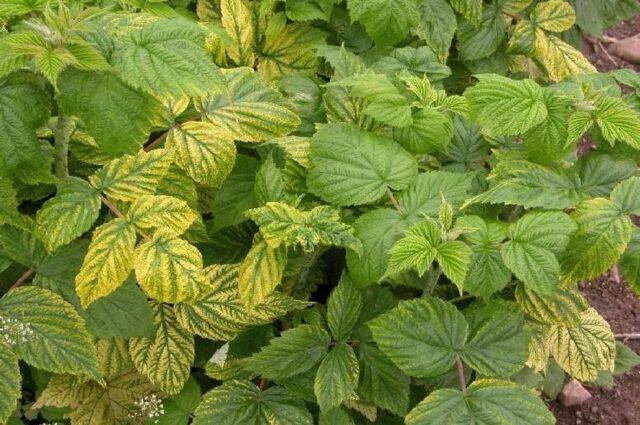
Infectious raspberry chlorosis cannot be treated; the diseased bush must be dug up and burned
Ring spot
The viral disease appears as pale yellow or light green ring-shaped patterns on raspberry leaves. Symptoms develop in late spring or early summer, may disappear by August, but then return again. Raspberries turn yellow, slow down their development, their shoots become brittle and short, and the berries quickly dry out.
Prevention of ring spot is the use of healthy seedlings and varieties with strong immunity. There is no treatment for the disease; affected raspberries are simply destroyed.
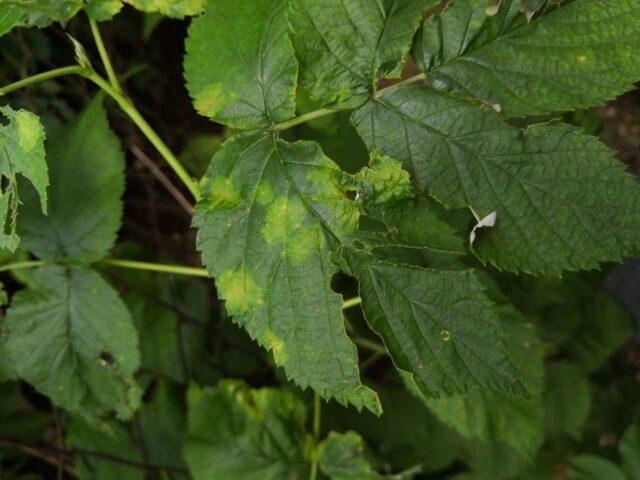
The carrier of raspberry ringspot is often a nematode
Mosaic
Against the background of a viral disease, raspberries turn yellow in early summer, their leaves become deformed and become lumpy. The root shoots gradually degenerate and become thinner, and the berries lose their juiciness and softness.
Mosaic rarely causes the death of raspberries, but impairs fruiting. It is impossible to cure the disease; infected specimens are destroyed. Attention should be paid to prevention - pruning, soil treatment and spraying against aphids.
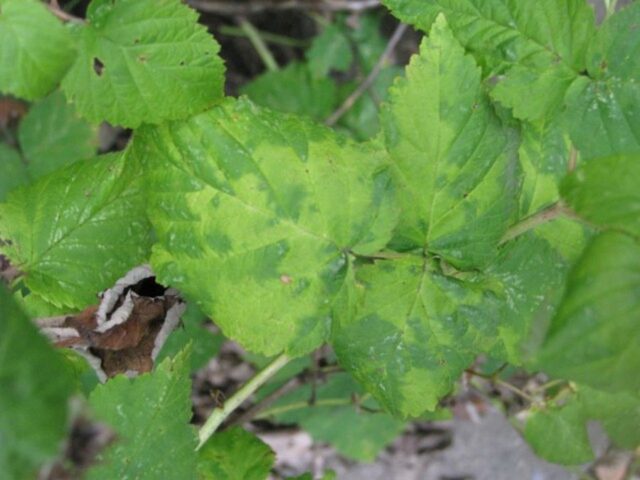
Raspberries affected by mosaics are less tolerant of cold weather
Rust
The fungal disease most often spreads to raspberries from sedge or coniferous trees in warm and humid weather. In the second half of spring, the leaves on the inside become covered with small bumpy spots of a reddish-brown color. The outer surface of the plates turns yellow. Over time, the spots grow and occupy the entire leaf. The raspberry plates dry from the edges to the middle and crumble.
You can cope with rust by spraying with HOM and Topaz. Treatment is carried out twice with an interval of three weeks. For prevention, you can spray the raspberries with copper sulfate or Bordeaux mixture even before the buds open.
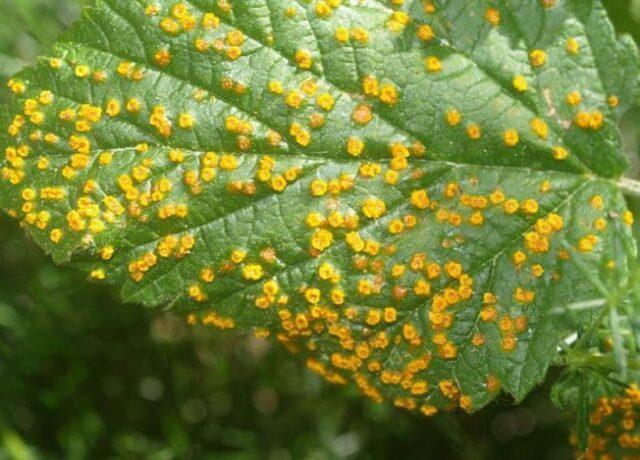
Against the background of rust, raspberries turn yellow, lose frost resistance and bear small, tasteless fruits
Root cancer
Raspberry root canker develops on alkaline soils in dry climates. Most often it affects shrubs with open damage to underground rods. Galls, or small growths, form on the roots, soft at first and then woody, sometimes they spread to the neck of the stem. Under the influence of the disease, raspberries cease to receive a sufficient amount of moisture and nutrients, turn yellow, develop worse and die over time.
Root cancer cannot be cured, so the bush is simply destroyed. The soil on the site is then treated with copper sulfate and no other plants are planted to replace the eliminated one for three years.
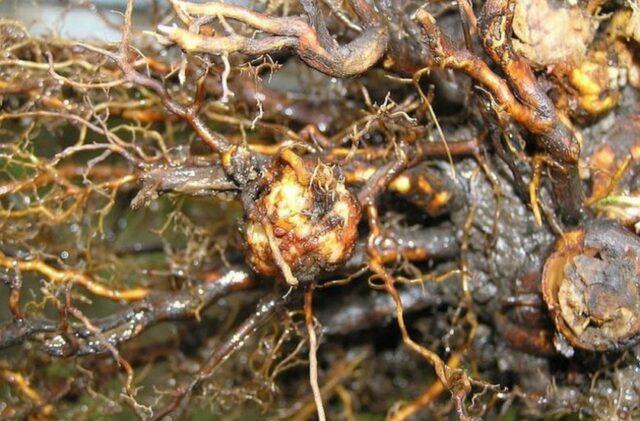
Treating the roots of seedlings with copper sulfate helps prevent cancer.
Late blight
The late blight fungus also affects the roots of raspberries and for a long time practically does not make itself felt. But as the disease develops, the plant turns yellow and begins to shed its leaves, and then dies completely. The fungal pathogen is most active in humid weather at a temperature of about 20 °C. The disease can be recognized not only by a change in the color of the raspberry leaves, but also by the drying out of the side shoots, as well as by the darkening of the core of the buds.
Fungicidal agents have almost no effect on the causative agent of late blight, so severely damaged bushes are simply eliminated. If the raspberries turn slightly yellow and look relatively healthy, you can water the soil around them with copper sulfate.
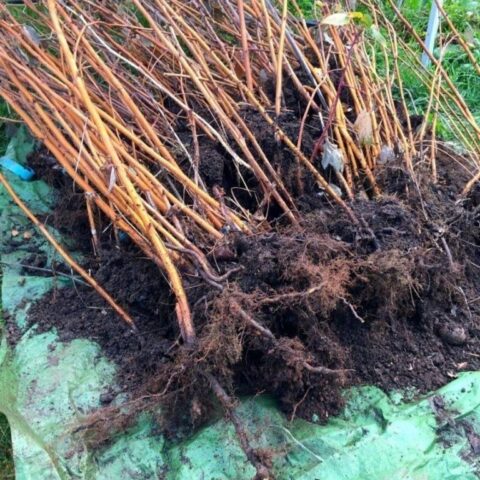
To prevent late blight, raspberry seedlings must be thoroughly treated with fungicides before planting.
Curly
Viral leaf curl of raspberry leaves leads to deformation of the bush plates. They become smaller and curl inward, the underside turns yellow or brown. Ripening raspberries become smaller, acquire dryness and a sour taste.
It is impossible to cure curl, so affected plants are removed from the area and burned. For prevention, it is necessary to spray raspberries with Bordeaux mixture in early spring and treat the roots of seedlings with a solution of potassium permanganate before planting.
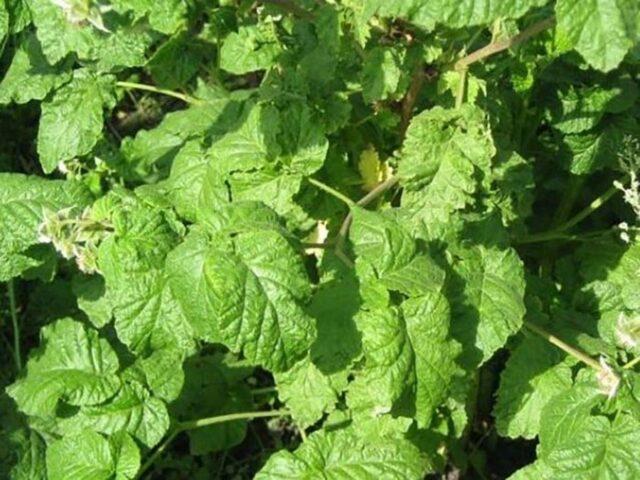
Curl can completely destroy a raspberry bush in just a few days
Raspberry pests
The leaves of remontant raspberries turn yellow not only under the influence of diseases, but also when infected by pests. Indirect signs of the presence of insects are holes and other damage on the blades of the bush.
Aphid
The garden pest is small in size, but at the same time forms very large colonies. Raspberries can be affected by green, gray and black aphids; the latter varieties are easier to notice on the leaves of the bush. Insects suck the juice from the young plates, as a result the plant turns yellow and withers.
You can get rid of aphids using a homemade solution - dilute 1 kg of wood powder and a crushed bar of laundry soap in a bucket of water. Wormwood or onion infusions also help. Treating raspberries with Karbofos and similar insecticides gives a good effect.
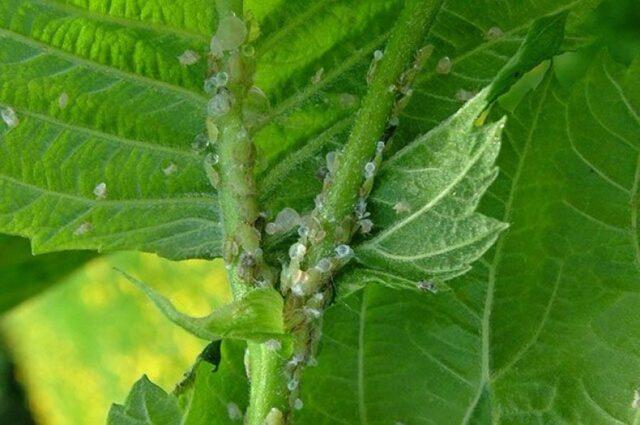
An additional danger of aphids is that the insect carries raspberry viral diseases
Spider mite
Spider mites attack raspberries in warm and dry weather with a lack of moisture.The insect can be found on the underside of leaves; usually the pest has a red, brown or yellowish body. The presence of a mite is indicated by a thin web on the shoots of a bush.
Under the influence of the pest, raspberries turn yellow, their foliage curls and withers. To combat mites, general insecticidal preparations are used, as well as garlic infusion or a solution of wood ash.
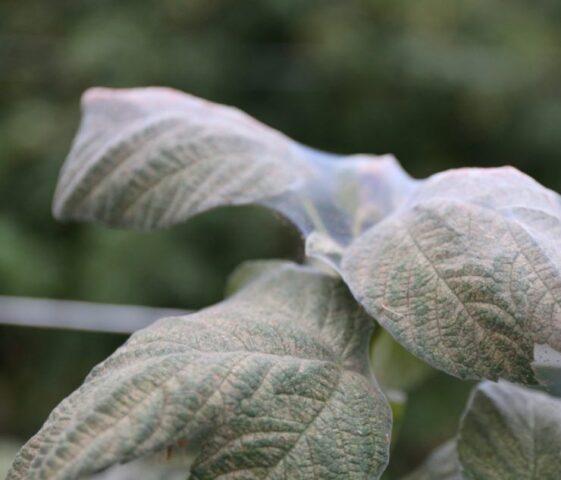
Simple spraying of raspberries along the crown helps prevent the appearance of spider mites.
Improper care
Raspberries turn yellow if agricultural practices are incorrect. In particular, fungi and pests especially often attack thickened plants. If you do not thin out the shoots, the access of fresh air deep into the bushes will inevitably deteriorate, and moisture will stagnate on the leaves. Sanitary cutting of raspberries is necessary annually. In the process, you should remove not only dry branches, but also root shoots, as well as crooked shoots growing inside the bush.
Raspberries often turn yellow due to excess moisture. If the weather is rainy, then there is no need to additionally water the bush. It is better to pay attention to periodically loosening the soil - this will prevent it from acidifying and forming a hard crust.
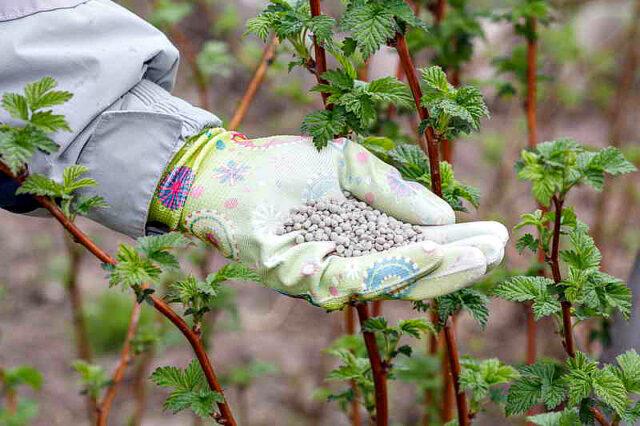
After prolonged rains, which wash away beneficial substances from the soil, raspberries especially need feeding
Lack of moisture
Raspberries turn yellow not only when over-watered, but also due to drought. During hot summer periods, the plant must be watered weekly, each time adding 10-30 liters of water under the bush. To ensure that moisture evaporates more slowly, it is recommended to mulch the soil with sawdust, straw or wood chips.
Increased soil acidity
Raspberries turn yellow on the leaves in soils with excess nitrogen. If the soil on which the shrub grows is too acidic in composition, it is necessary to add 1 kg of wood ash or dry alkali per 1 m2. After this, the soil under the raspberries is carefully dug up. This treatment helps bring the soil acidity level closer to neutral.
What to do if the raspberries turn yellow
At the first signs of yellowing of raspberries, it is necessary to carefully examine the foliage and shoots of the bush. If the plates have spots, dots, plaque or holes, or unusual patterns or deformations, the discoloration is most likely caused by pests or fungi. It is necessary to carry out several treatments with copper-containing preparations or insecticides, observing intervals of 2-3 weeks.
If spraying does not have an effect, and the raspberries still turn yellow, care should be reconsidered. Extra fertilizing is applied to the soil, watering is normalized - the soil should not dry out, but waterlogging should not be allowed. If necessary, the shrub is pruned, and as a last resort, the plant is dug up and replanted, simultaneously inspecting the roots for damage.
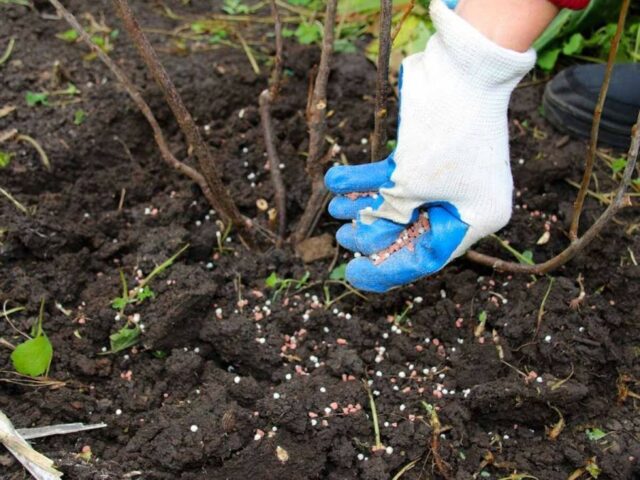
Remontant raspberries require fertilizing more often than usual, since they consume nutrients more actively
Prevention
General rules of prevention help prevent yellowing of raspberries. They reduce the likelihood of fungal development and make the shrub more resistant to pests. In particular, it is necessary:
- select healthy seedlings without damage and disinfect their roots in a weak solution of potassium permanganate;
- water the soil in the garden before planting raspberries with fungicidal agents;
- do not allow the soil to dry out or become waterlogged;
- Apply complex fertilizers for raspberries three times a season;
- regularly carry out sanitary and formative pruning;
- promptly remove the root shoots of the bush.
When growing raspberries, it is important to keep the area clean. With the onset of autumn, it is necessary to remove all plant debris, since this is where fungal spores and pest larvae usually overwinter.
Conclusion
Raspberry leaves turn yellow - this problem most often appears against the background of fungal diseases and improper care. Sometimes discoloration of the plates is caused by harmful insects. If yellowing occurs, it is important to immediately begin treatment of raspberries, since in the later stages it is much more difficult to solve the problem.
